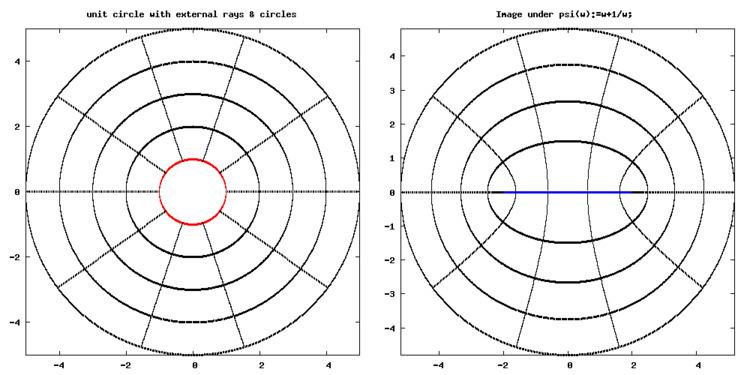 | ||
An external ray is a curve that runs from infinity toward a Julia or Mandelbrot set. Although this curve is only rarely a half-line (ray) it is called a ray because it is an image of a ray.
Contents
- History
- Notation
- Dynamical plane z plane
- Uniformization
- Formal definition of dynamic ray
- Properties
- Formal definition of parameter ray
- Definition of M displaystyle Phi M
- External angle
- Computation of external argument
- Transcendental maps
- Parameter rays
- References
External rays are used in complex analysis, particularly in complex dynamics and geometric function theory.
History
External rays were introduced in Douady and Hubbard's study of the Mandelbrot set
Notation
External rays of (connected) Julia sets on dynamical plane are often called dynamic rays.
External rays of the Mandelbrot set (and similar one-dimensional connectedness loci) on parameter plane are called parameter rays.
Dynamical plane = z-plane
External rays are associated to a compact, full, connected subset
External rays together with equipotential lines of Douady-Hubbard potential ( level sets) form a new polar coordinate system for exterior ( complement ) of
In other words the external rays define vertical foliation which is orthogonal to horizontal foliation defined by the level sets of potential.
Uniformization
Let
and Boettcher map(function)
where :
Boettcher map
where :
Formal definition of dynamic ray
The external ray of angle
Properties
External ray for periodic angle
and its landing point
Uniformization
Let
and Boettcher map (function)
it can be normalized so that :
where :
Jungreis function
In the case of complex quadratic polynomial one can compute this map using Laurent series about infinity
where
Formal definition of parameter ray
The external ray of angle
Definition of Φ M {displaystyle Phi _{M},}
Douady and Hubbard define:
so external angle of point
External angle
Angle
Principal value of external angles are measured in turns modulo 1
1 turn = 360 degrees = 2 * Pi radians
Compare different types of angles :
Computation of external argument
Transcendental maps
For transcendental maps ( for example exponential ) infinity is not a fixed point but an essential singularity and there is no Boettcher isomorphism.
Here dynamic ray is defined as a curve :
Parameter rays
Mandelbrot set for complex quadratic polynomial with parameter rays of root points
Parameter space of the complex exponential family f(z)=exp(z)+c. Eight parameter rays landing at this parameter are drawn in black.
